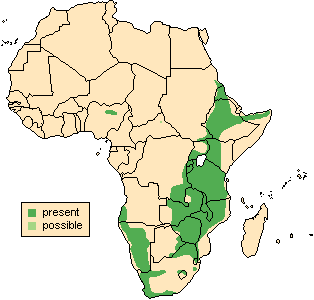![]() Return
to Artiodactyla
Return
to Artiodactyla
Classification
|
 Oreotragus
oreotragus
Oreotragus
oreotragus
Klipspringer
![]()
Taxonomy
 |
 |
 |
Click on the pictures above for a larger view of the
photographs
|
||
General Characteristics
Body Length: 75-115 cm / 2.5-3.8 ft.
Shoulder Height: 45-60 cm / 1.5-2 ft.
Tail Length: 7-13 cm / 3-5 in.
Weight: 10-18 kg / 22-40 lb.The short coat is made of hollow, brittle hairs that range in colour from gray, brown, and yellow to olive green, giving the coat a grizzled appearance. The belly and insides of the ears are white. The ears have a conspicuous black border. The nose is black, as are the large preorbital glands. The body is sturdy and the hindquarters are overdeveloped. The hooves look like vertical cylinders. The horns, found in males (and sometimes females in east African), are wide-set on the forehead and rise vertically as short spikes. Ridged at the base, they grow up to 15 cm / 6 inches long.
Ontogeny and Reproduction
Gestation Period: 7 months.
Young per Birth: 1
Weaning: 4-5 months.
Sexual Maturity: At about 1 year.
Life span: Up to 15 years.After birth, the young remain concealed in crevices for 2-3 months.
Ecology and Behavior
The klipspringer is mainly active during the early morning and late afternoon, resting during the hottest part of the day among rocks or beneath overhangs. Their remarkable agility among the steep rocks of native kopjes can be attributed to a set of unique feet. The klipspringer stands on the very tips of its almost circular hooves, each with the diameter of about a dime. The strong back legs can project the klipspringer up a smooth wall, and they can jump onto a projection the size of a silver dollar with all four feet. Pairs have exclusive territories of 8-49 hectares in size, which they defend fiercely, and rarely leave. Both sexes are involved in marking with their preorbital glands. A sentinel, or watcher, is posted at all times within the group, and this animal is responsible for the safety of the group. When alarmed, the sentinel emits a shrill whistle to alert the other animals, at which they head for cover.Family group: Monogamous pairs with young offspring.
Diet: Grasses, leaves, blossoms, fruit, lichens.
Main Predators: Leopard, caracal, serval, hyena, jackal, large snakes.
Distribution
Steep rocky terrain [especially kopjes] in savannas in eastern and southern Africa.

Range Map (Redrawn from IEA, 1998)
Conservation Status
The klipspringer is classified as a low risk, conservation dependent species by the IUCN (1996). However, O. o. porteousi is considered endangered.
Remarks
While most ungulates are "tiptoers", the klipspringer is the only artiodactyl to take this to the extreme, standing on the very tips of its hooves. Klip is Dutch for rock: hence klipspringer means "a rock-jumper". Oros (Greek), genitive oreos, a mountain; tragos (Greek) a he-goat.
Literature Cited
IEA (Institute of Applied Ecology). 1998. Oreotragus oreotragus. In African Mammals Databank - A Databank for the Conservation and Management of the African Mammals Vol 1 and 2. Bruxelles: European Commission Directorate. Available online at http://gorilla.bio.uniroma1.it/amd/amd184b.htmlNowak, R. M. [editor]. 1991. Walker's Mammals of the World (Fifth Edition). Baltimore: The Johns Hopkins University Press.
Walther, F. R. 1990. Duikers and Dwarf Antelopes. In Grzimek's Encyclopedia of Mammals. Edited by S. P. Parker. New York: McGraw-Hill. pp. 325-343.
Wilson, D. E., and D. M. Reeder [editors]. 1993. Mammal Species of the World (Second Edition). Washington: Smithsonian Institution Press. Available online at http://nmnhwww.si.edu/msw/
Return to Artiodactyla

![]()
© Brent Huffman, www.ultimateungulate.com |
|
|